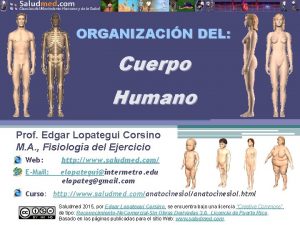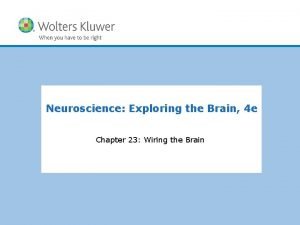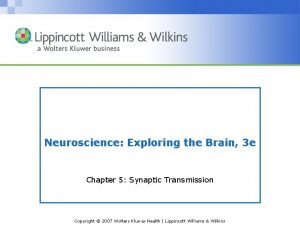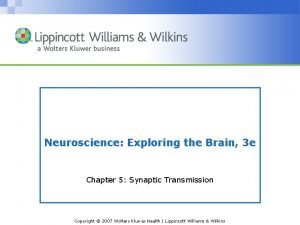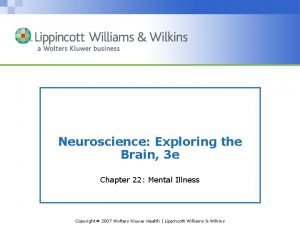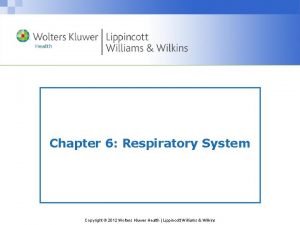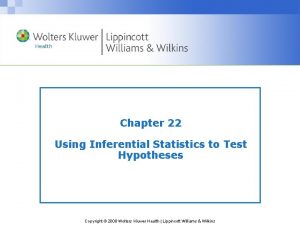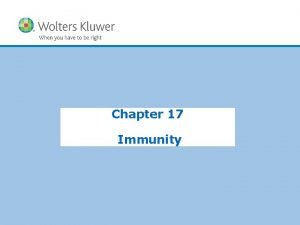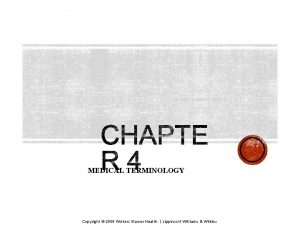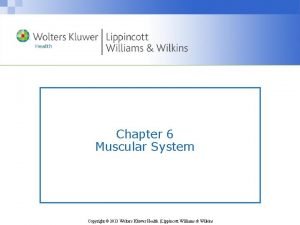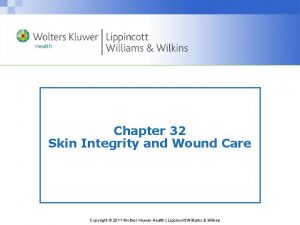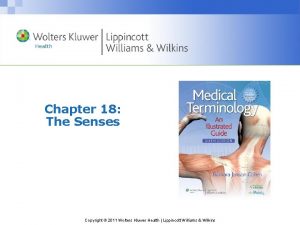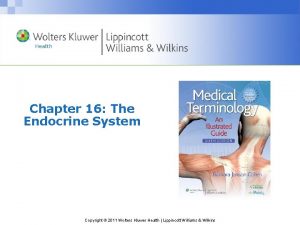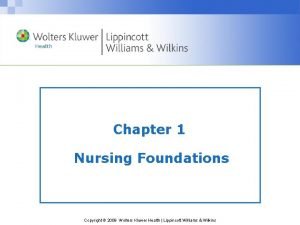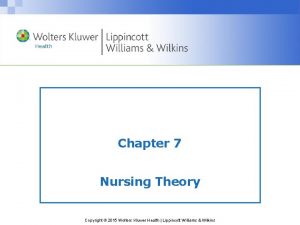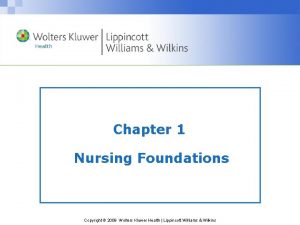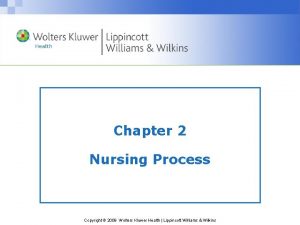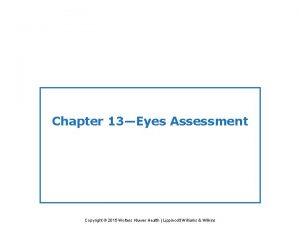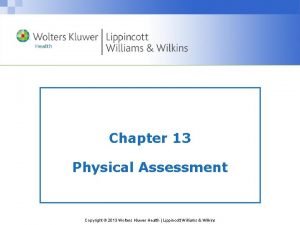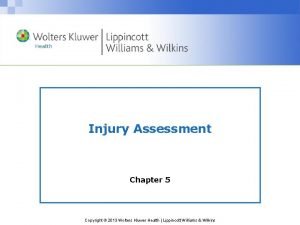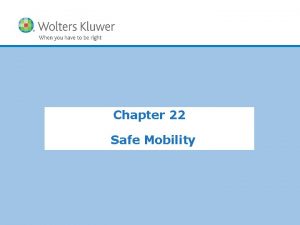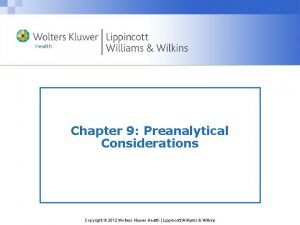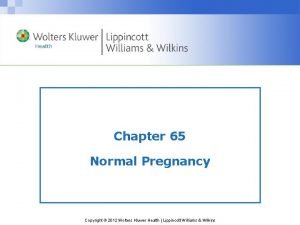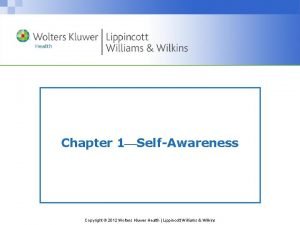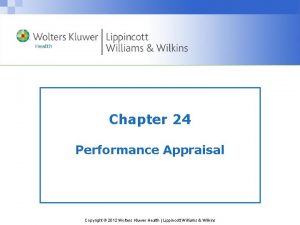Chapter 34 Nursing Assessment Copyright 2012 Wolters Kluwer



















- Slides: 19

Chapter 34 Nursing Assessment Copyright © 2012 Wolters Kluwer Health | Lippincott Williams & Wilkins

Nursing Assessment • Nursing assessment – The systematic and continuous collection and analysis of information about a client – The nurse carefully collects this information, also called data, during the first step of the nursing process. – All steps of the nursing process depend on the nursing assessment. Copyright © 2012 Wolters Kluwer Health | Lippincott Williams & Wilkins

Data Collection • Sources of information about the client – The client and family – Other members of the healthcare team – The client’s previous and present health records, laboratory reports, and reference books – Physical examination Copyright © 2012 Wolters Kluwer Health | Lippincott Williams & Wilkins

Objective Data • Objective data – All measurable and observable pieces of information about the client and his or her overall state of health. – Only precise, accurate measurements or clear descriptions are used. – Vital signs, height, weight, and urine volume – Measurements of body structure and function using instruments – Laboratory test results; radiologic diagnostic tools Copyright © 2012 Wolters Kluwer Health | Lippincott Williams & Wilkins

Subjective Data • Subjective data – The client’s opinions or feelings about what is happening – The client communicates through written words and body language. – This information cannot be confirmed through any other source. – The nurse needs sharp interviewing, listening, and observing skills. Copyright © 2012 Wolters Kluwer Health | Lippincott Williams & Wilkins

Question Is the following statement true or false? The client complains of a headache and fever; however, she has not recorded the temperature. This is an example of subjective data. Copyright © 2012 Wolters Kluwer Health | Lippincott Williams & Wilkins

Answer True This data is subjective because it is based on the client's feelings. If the temperature is measured by a thermometer then, that data would be objective. Copyright © 2012 Wolters Kluwer Health | Lippincott Williams & Wilkins

Data Collection • Methods to collect data – Observation – Health interview – Physical examination Copyright © 2012 Wolters Kluwer Health | Lippincott Williams & Wilkins

Observation • Assessment tool that relies on the use of the five senses to discover information about the client – Visual observation – Tactile observation – Auditory observation – Olfactory or gustatory observation Copyright © 2012 Wolters Kluwer Health | Lippincott Williams & Wilkins

The Health Interview • The health interview or nursing history – A way of soliciting information from the client – Uses combinations of open-ended questions, detailed questions, and observational and tactile skills – Clients have the right to refuse to answer questions that they believe are too personal. • Medical history – When a physician obtains information from the client Copyright © 2012 Wolters Kluwer Health | Lippincott Williams & Wilkins

Question Is the following statement true or false? A 15 -year-old client who is experiencing lower abdominal cramps admits that she has had an abortion in the recent past, of which her family has no knowledge. The nurse is required to inform her parents as she is under age. Copyright © 2012 Wolters Kluwer Health | Lippincott Williams & Wilkins

Answer False The nurse must protect the confidentiality of the client, never revealing any information previously unknown to the family without the client’s permission. Copyright © 2012 Wolters Kluwer Health | Lippincott Williams & Wilkins

Components of the Nursing History • A complete health history helps develop an effective plan of care for the client. It includes: – Biographical data – Reason for coming to the healthcare facility – Recent health history – Important medical history – Pertinent psychosocial information – Activities of daily living (ADL) Copyright © 2012 Wolters Kluwer Health | Lippincott Williams & Wilkins

Data Analysis • During and after data collection, critically examine each piece of information to determine its relevance to the client’s health problems and its relationship to other pieces of information. • Through systematic data analysis, draw conclusions about the client’s health problems. • During data analysis, use critical thinking skills. Copyright © 2012 Wolters Kluwer Health | Lippincott Williams & Wilkins

Data Analysis (cont’d) • Recognizing significant data – When preparing to analyze data, ask yourself which items are pertinent to client care and which are not. • Validating observations – Validate observations by checking if they agree with what the client is experiencing. • Recognizing patterns or clusters – Symptoms can be grouped together in clusters for further analysis. Copyright © 2012 Wolters Kluwer Health | Lippincott Williams & Wilkins

Systematic Data Analysis (cont’d) • Identifying strengths and problems – While assessing the client, the nurse should look for strengths the client has that can be used in coping with problems. • Reaching conclusions – The client has no problem. – The client may have a problem. – The client is at risk for a problem. – The client has a clinical problem. Copyright © 2012 Wolters Kluwer Health | Lippincott Williams & Wilkins

Question Is the following statement true or false? A medical diagnosis falls in the domain of nursing, and nursing staff may treat it without consulting a physician. Copyright © 2012 Wolters Kluwer Health | Lippincott Williams & Wilkins

Answer False A medical diagnosis is a collaborative problem; the nursing staff must consult a physician and work together to resolve the problem. A nursing diagnosis falls in the domain of nursing, and nursing staff may treat it without consulting a physician. Copyright © 2012 Wolters Kluwer Health | Lippincott Williams & Wilkins

End of Presentation Copyright © 2012 Wolters Kluwer Health | Lippincott Williams & Wilkins
 Wolters kluwer health
Wolters kluwer health Wolters kluwer health
Wolters kluwer health Wolters kluwer
Wolters kluwer Wolters kluwer
Wolters kluwer Synaptic integration
Synaptic integration Wolters kluwer health
Wolters kluwer health Wolters kluwer
Wolters kluwer Wolters kluwer
Wolters kluwer Wolters kluwer
Wolters kluwer Wolters kluwer
Wolters kluwer Wolters kluwer health
Wolters kluwer health Chapter 25 assessment of cardiovascular function
Chapter 25 assessment of cardiovascular function Wolters kluwer health
Wolters kluwer health Wolters kluwer
Wolters kluwer Wolters kluwer
Wolters kluwer Wolters kluwer pronunciation
Wolters kluwer pronunciation Wolters kluwer
Wolters kluwer Chapter 48 skin integrity and wound care
Chapter 48 skin integrity and wound care Wolters kluwer
Wolters kluwer Wolters kluwer
Wolters kluwer


